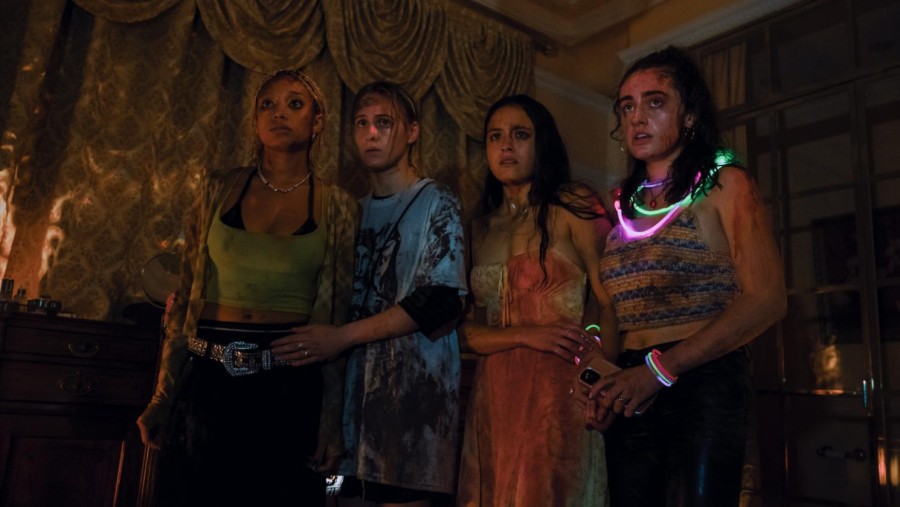To critics of ‘Bodies Bodies Bodies’: Let movies be stupid again, please
Described as “Euphoria With Knives” by New York Times critic Lena Wilson, Halina Reijn’s spirited Gen Z slasher “Bodies Bodies Bodies” garnered some negative first impressions from viewers who either didn’t realize it was satire or hate fun.
September 27, 2022
Spoiler warning: This article contains spoilers for “Bodies Bodies Bodies.”
In a laughably ironic display of a writer entirely missing the point, New York Times critic Lena Wilson suggests in her review of “Bodies Bodies Bodies” that “the only thing that really sets [the film] apart is its place in the A24 hype machine, where it doubles as a 95-minute advertisement for cleavage and Charli XCX’s latest single.”
Like other critics, Wilson is caught up in the unlikability of the film’s neurotic, overtly wealthy 20-something protagonists. She suggests that it was made for other equally insufferable 20-somethings to watch, so they can reassure themselves that they couldn’t possibly be that obnoxious. But, like most good films, “Bodies Bodies Bodies” extends the cinematic experience into the real world, correctly predicting that the discussions surrounding its playfully bloody narrative would only reflect the very thing it is attempting to satirize: a lack of self-awareness and the makings of a miscommunication among the film’s characters, which rapidly whittles down its ensemble cast to the pair it opens with.
Though aesthetically different, “Bodies Bodies Bodies” in some ways evokes the conversations that ensued following “Get Out” and “Parasite” — in “Get Out,” director Jordan Peele expertly deconstructs racism by weaving it together with classic horror tropes, forcing the viewer into the position of Chris (Daniel Kaluuya), regardless of their actual racial identity and experiences with discrimination.
However, many viewers — primarily white, “progressive” liberals — left the theater having learned all the wrong lessons. Because Peele does such an extraordinary job placing the audience in Chris’ shoes, viewers fail to realize he is also satirizing the audience’s faults, not just their borderline-creepy obsession with Obama. Tari Ngangura says it best in a Vice article: “It’s white liberals who will so skillfully disengage from the subject matter so as to see themselves only as spectators and not perpetrators capable of exerting the same macro and micro-aggressions endured by Chris, at the hands of his white girlfriend’s progressive middle-class family.”
Similarly, rich people were tripping over their own words of praise following the release of “Parasite,” failing to actually learn anything from it. Though the film casts capitalism as its villain — not the wealthy or the poor who are perpetually stuck in its vicious cycle — it still succeeds in highlighting the mistreatment of the lower class for the benefit of the continued financial and personal gain of the upper class. This alone should have warned the rich against publicly endorsing the film, as celebrities like Elon Musk, Chrissy Teigen and even Obama so ignorantly did. In this way, they only proved the film’s point — that the wealthy lack self-awareness to the point of oblivion to reality. It appears then that the director, Bong Joon-ho, like Peele, does most of the critical thinking for his audience — and even then, it isn’t enough.
Of course, that isn’t to say that “Bodies Bodies Bodies” is comparable to Peele’s satirization of race and white liberalism, nor could it ever come close to Bong’s impact on cinema as a whole, and the moderately progressive attitude towards international film that he inspired within Hollywood. But “Bodies Bodies Bodies” isn’t just a sexed-up slasher about a bunch of hot 20-somethings who kill each other either — though I certainly don’t see why that would be a point of criticism in the first place. Unless you just hate fun.
While “Bodies Bodies Bodies” isn’t necessarily thematically complex, it still manages to poke fun at a generation obsessed with “woke culture,” without actually being offensive. Instead, it points out where this performative allyship becomes counterproductive and downright absurd, while remaining light and true to the horror-comedy subgenre. A lot of this can be attributed to Halina Reijn’s portrayal of Generation Z, which is often overdone in film and television to a degree to which it feels tacky and unnatural. With both rising and recognizable actors like Rachel Sennott and Pete Davidson, though, Reijn struck gold — the dialogue is effortlessly funny and often sounds like a conversation you might overhear on a college campus like ours. Their casual, but individualized wardrobes reflect the many different trends and styles of young people today, while simultaneously displaying a certain level of “diversity” within their friend group.
“Bodies Bodies Bodies” also does something a lot of horror movies fail to do — it elicits realistic reactions from its characters. When the first of the slasher film’s victims is found stumbling around with his throat slit, the group’s initial reaction is to call 911 and run. Even if they predictably fail in escaping, their frenzied yet logical instinct to flee is more than can be said for the archetypal horror characters who choose to venture into the dark basement by themselves or yell “hello” to a potential intruder. The weirdly specific horror movie sub-genre in which a group of friends meet in a remote location only to be killed off one by one is played out, sure, but no movie has done it as realistically as “Bodies Bodies Bodies.” We all want to be the clever hero who survives, but most of us are probably much more like Alice (Rachel Sennott), who has multiple anxiety-induced breakdowns during the hunt for the film’s “killer.”
In a movie that uses “upper middle class” as a slur, is refreshingly casual about lesbians, and somehow manages to hinge an entire punchline on the audience’s knowledge of TikTok culture without being completely insufferable. The last thing on my mind is Amandla Stenberg’s cleavage. In using shallow critique to criticize the “shallowness” of the film’s characters, critics are only proving that they’re not in on the joke. If there’s one thing that Lena Wilson and I can agree on, though, it’s this: Lee Pace is absolutely, tragically underutilized.
Contact Lorena Campes at [email protected].

























































































































































